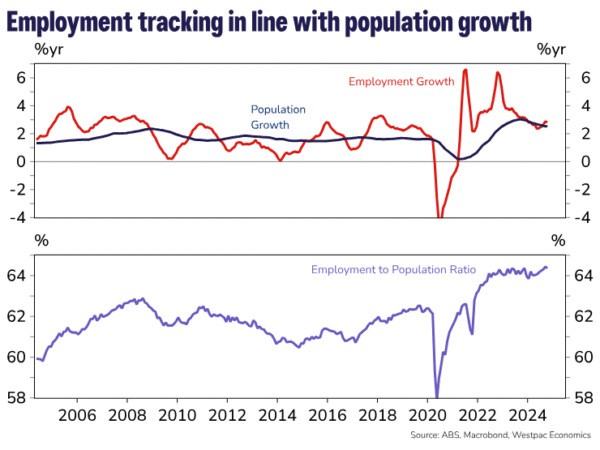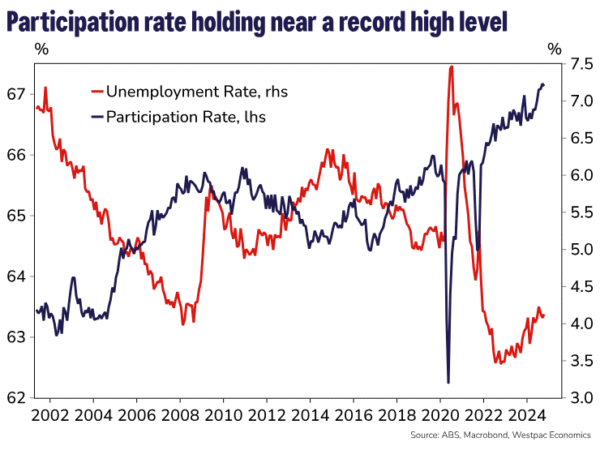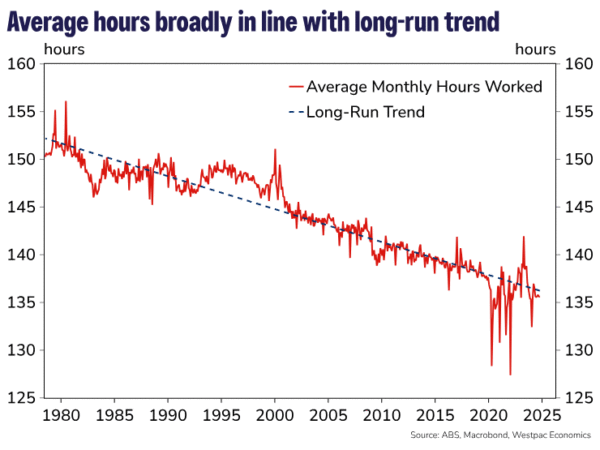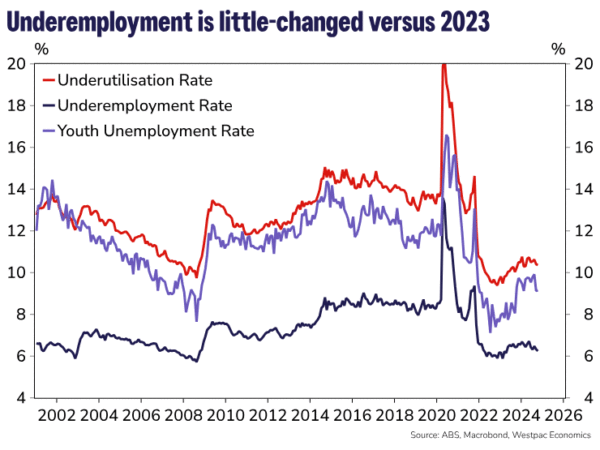Employment: +15.9k (from +61.3k). Unemployment Rate: 4.1% (from 4.1%). Participation Rate: 67.1% (from 67.2%).
In October, employment rose by +15.9k (0.1%), slightly below Westpac’s forecast of +20k and under the market consensus forecast of +25k. This marks the softest monthly increase in employment since May, when a modest decline was reported, and a departure from the above-trend strength from more recent months – an average of around +50k per month over the September quarter. On a three-month average basis, employment growth has eased slightly from 2.9%yr in September to 2.8%yr in October. That was enough to see the employment-to-population ratio ease marginally from 64.44% to 64.36%, although both figures still round to a record high 64.4%.
We interpret October’s employment print as a normalisation from above-trend momentum that emerged over the last few months. While one month certainly does not mark a trend, there does not seem to be any ‘suspicious’ causes behind the October step-down in employment growth that could point to an unwind next month. Population growth is slowing broadly as expected, and that will continue to see the monthly prints for employment ease accordingly – a result of the Labour Force Survey’s design of estimating sample ratios and ‘scaling’ the implied level changes to population growth.
One factor worth bearing in mind near-term is that employment growth was much stronger than expected during the October-November periods of 2022 to 2023. This reflected an anticipation of stronger demand in the lead-up to Black Friday Sales and the Christmas spending season, as households concentrated spending during discount periods to alleviate cost-of-living pressures. However, this time around it may be the case that with cost-of-living pressures easing, population growth slowing and a greater capacity for employers offer more hours rather than expand headcount, the Black Friday/Christmas impetus is not as materially positive as it was in previous years.
Most analysts – including Westpac – anticipated the participation rate to hold flat at its record high of 67.2% in October. In the event, the participation rate fell by just 0.04ppt, but it was enough for it to round down from 67.2% to 67.1% (from 67.18% to 67.14%). This is still a result certainly worth celebrating – a near record proportion of the population actively engaging in the labour market. The future path for labour force participation depends critically on the balance of cyclical forces and the clear structural uptrend supported by demographic factors. One month’s result is not entirely informative, and whether a gradual downtrend in labour force participation ensues – as we anticipate – remains to be seen.
The tick-down in participation saw the labour force expand by +24.2k, more than the increase in employment recorded in the month, therefore implying a slight increase in the level of unemployment (+8.3k). Overall, this was not enough to see the unemployment rate budge from its current level of 4.1%, as it has done for the past three consecutive months.
The RBA are also closely monitoring developments across other measures of labour force slack and the dynamics around average hours worked – if there were to be clearer signs of easing labour market conditions, it would likely be initially more apparent in these more sensitive measures of underutilisation.
Growth in monthly hours worked rose 0.1%mth in October and 2.2%yr on a three-month average basis, matching the increase in employment and therefore implying no change to average hours worked. Employers have used average hours as a lever to adjust their labour demand quickly in response to rapidly evolving economic conditions over the past two years. With the large swings in average hours mostly behind us, there is no clear evidence of a renewed weakening in labour demand via average hours. As seen in the chart below, average hours are still tracking broadly in line with the historical downtrend that has been in place since the 1970s.
Other measures of underutilisation are also not ringing any alarm bells at this stage. The underemployment rate – which measures those that are willing and able to work more hours than they currently do – fell once again from 6.3% in September to 6.2% in October, the lowest result since April 2023. The underutilisation rate, which combines both unemployment and underemployment, held flat at 10.4%, the lowest since March 2024. Youth unemployment also remains well below the levels observed prior to the pandemic, currently at 9.2%.
Today’s data is a reminder that the Australian labour market remains in relatively solid health and is gradually becoming more balanced. With employment growth slowing broadly in line with population growth and average hours holding steady, there are few signs that labour demand is capitulating to an extent that warrants concern. While virtually all measures of underutilisation are signalling that labour market conditions remain somewhat tight, yesterday’s wages data suggests this is not translating to stronger wage inflation pressures. On balance, today’s update will see the RBA continue to remain focused on the dynamics around underlying inflation.

















